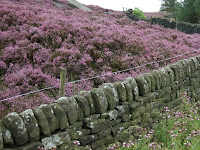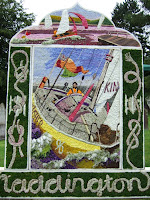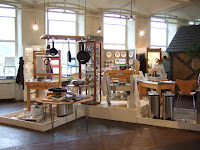 Huddersfield is number 3 in terms of towns with the most listed buildings. We started our day with a town trail which took us around the major ones, mainly built in prosperous Victorian times and some, art deco style, from the early 20th century.
Huddersfield is number 3 in terms of towns with the most listed buildings. We started our day with a town trail which took us around the major ones, mainly built in prosperous Victorian times and some, art deco style, from the early 20th century. From Huddersfield we took the scenic route over the Bradfield Moors. Despite the damp weather the hills looked wonderful, with the heather at its best.
From Huddersfield we took the scenic route over the Bradfield Moors. Despite the damp weather the hills looked wonderful, with the heather at its best.We called by Taddington to view another well dressing. The theme was a local Derbyshire lass, Ellen McArthur, who,
 despite growing up as far from the sea as is possible in the UK, holds many sailing records including those for solo round the world trips.
despite growing up as far from the sea as is possible in the UK, holds many sailing records including those for solo round the world trips.We continued on to Eyam village to visit Eyam Hall. On one of the best conducted tours we have been on, we learnt the history of the Wright family, who have lived there since it was built in 1670s. The Wrights have always been a family who worked on the land, or in industry, thus were practical people, a fact that is reflected many times in the house and furnishings.
 This picturesque village has a fascinating history. In 1665 a local tailor received a parcel of cloth from London. Unfortunately the cloth contained some unwelcome hitchhikers: fleas. London fleas in 1665 were not a good thing to be near and their arrival in this sleepy little hollow in the Dales lead to an outbreak of plague in the village.
This picturesque village has a fascinating history. In 1665 a local tailor received a parcel of cloth from London. Unfortunately the cloth contained some unwelcome hitchhikers: fleas. London fleas in 1665 were not a good thing to be near and their arrival in this sleepy little hollow in the Dales lead to an outbreak of plague in the village.  Plaques on the houses tell of the names of the people living in each cottage, and how many died.
Plaques on the houses tell of the names of the people living in each cottage, and how many died.The very wise vicar imposed strict quarantine on the village: no one was allowed to enter or leave; and he held his church services in the open air to assist in avoiding cross infection. Neighbouring villagers could sell food to the Eyam villagers by leaving it by a
 rock outside the village, and the money to pay for the food was left in a pool of vinegar in a depression in the rock.
rock outside the village, and the money to pay for the food was left in a pool of vinegar in a depression in the rock.Largely due to the foresight of the vicar, the outbreak was contained in this one village and eventually died out in 1666, 14 months and 260 victims later.
View Larger Map














 The next village was Great Hucklow. This small village was planning their annual village gala; all the gardens were decorated and two wells dressed.
The next village was Great Hucklow. This small village was planning their annual village gala; all the gardens were decorated and two wells dressed. 



















